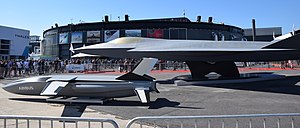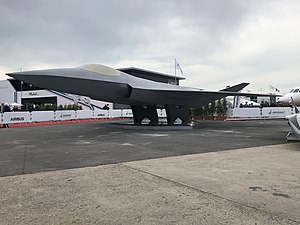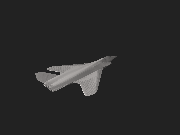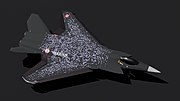Future Combat Air System
- View a machine-translated version of the French article.
- Machine translation, like DeepL or Google Translate, is a useful starting point for translations, but translators must revise errors as necessary and confirm that the translation is accurate, rather than simply copy-pasting machine-translated text into the English Wikipedia.
- Do not translate text that appears unreliable or low-quality. If possible, verify the text with references provided in the foreign-language article.
- You must provide copyright attribution in the edit summary accompanying your translation by providing an interlanguage link to the source of your translation. A model attribution edit summary is
Content in this edit is translated from the existing French Wikipedia article at [[:fr:Système de combat aérien du futur]]; see its history for attribution. - You may also add the template
{{Translated|fr|Système de combat aérien du futur}}to the talk page. - For more guidance, see Wikipedia:Translation.
| Future Combat Air System | |
|---|---|
 | |
| Mock-up of the NGF and a remote carrier at the 2019 Paris Air Show | |
| Role | Combat system of systems Type of aircraft |
| Manufacturer |
|
| Primary user | French Air and Space Force Spanish Air and Space Force German Air Force |
| New Generation Fighter | |
|---|---|
 | |
| Mock-up of the NGF at the 2019 Paris Air Show | |
| Role | Sixth-generation jet fighter Type of aircraft |
| National origin | France, Germany, Spain |
| Status | Project |
The Future Combat Air System (FCAS), (French: Système de combat aérien du futur; SCAF; Spanish: Futuro Sistema Aéreo de Combate; FSAC) is a European combat system of systems under development by Dassault Aviation, Airbus and Indra Sistemas. The FCAS will consist of a Next-Generation Weapon System (NGWS) as well as other air assets in the future operational battlespace.[1][2] The NGWS's components will be remote carrier vehicles (swarming drones) as well as a New Generation Fighter (NGF) - a sixth-generation jet fighter[3] that by around 2045 will replace current France's Rafales, Germany's Typhoons and Spain's EF-18 Hornets.[2][4]
A test flight of a demonstrator is expected around 2027 and entry into service around 2045.[5]
Contractors
Dassault will serve as prime contractor for the NGF, while Airbus will lead the development of accompanying remote carrier vehicles and the broader system's supporting combat cloud.[6] It will also be carrier-capable and will fly from the French Navy's future aircraft carrier.[7][8][9] Safran Aircraft Engines will be the prime contractor for the next-generation fighter aircraft engine, taking the lead in engine design and integration, while MTU Aero Engines, as the main partner for the first phase of research and technology, will take the lead in engine services.[10]
Each country has designated a national industrial coordinator, Airbus for Germany, Indra for Spain and Dassault for France.[11]
History
The FCAS concept was developed in the frame of the ETAP European Technology Acquisition Programme that was started in 2001 as a co-operation between Germany, France, Great Britain, Italy, Sweden and Spain. The new FCAS concept was a System of Systems (SoS) approach combining manned and unmanned systems, combat aircraft and UCAV, to be more efficient in the envisaged future scenarios than operating with manned systems alone.
In 2017 Germany and Spain asked Airbus to start working on a proposal for a new fighter under the name Future Combat Air System (FCAS).[12][13]
At the 2018 ILA Berlin Air Show, Dassault Aviation and Airbus announced an agreement to cooperate on the development of the FCAS.
In December 2018, the German Defence Ministry welcomed Spain's expression of interest in the programme.[14]
In June 2019 Spain joined the programme.[15]
In June 2023, Belgium became an observer to the FCAS programme.[16] The country is set to join the programme by June 2025.[17]
-
 Interactive 3D model of the FCAS mockup shown at the 2019 Paris Air Show
Interactive 3D model of the FCAS mockup shown at the 2019 Paris Air Show -
 Livery similar to the illustrations published by Dassault in early 2021
Livery similar to the illustrations published by Dassault in early 2021 -
 Illustration of the aircraft in flight, after the project as of 2022
Illustration of the aircraft in flight, after the project as of 2022
In December 2019 Safran and MTU Aero Engines agreed on the foundation of a 50/50 joint venture that will be incorporated by the end of 2021 to manage the development, production, and the after-sales support activities of the new engine to power the NGF.[18]
On 12 February 2020, the first phase (1A) of the research and development program was approved by the German parliament budget committee. It set up the industrial distribution of the first five subprograms.[19]
Development
Initial demonstrator
Phase 1A - Initial framework contract
Dassault, Airbus, together with their partners MTU Aero Engines, Safran, MBDA and Thales, were awarded the initial framework contract which launches the demonstrator phase. Beginning February 2020 it is expected to cover a period of 18 months of research and development. While it assigned different roles to the above-mentioned companies, Spain was left out:[20]
- New Generation Fighter (NGF), with Dassault Aviation as prime contractor and Airbus as main partner
- Unmanned systems Remote Carrier (RC) with Airbus as prime contractor and MBDA as main partner
- Combat Cloud (CC) with Airbus as prime contractor and Thales as main partner
- Engine with Safran and MTU Aero Engines as main partner
Phase 1B
Additional suppliers will be involved.
See also
References
- ^ Jennings, Gareth (15 November 2018). "Air superiority and nuclear deterrence dictate manned future fighter for France". Janes. Archived from the original on 15 November 2018.
- ^ a b Pike, John. "France + Germany - Next Generation Weapon System". Global security. Archived from the original on 21 November 2022.
- ^ Roblin, Sebastien (5 February 2019). "Forget the F-22 or Su-57: Europe Wants a Deadly 6th Generation Stealth Fighter". The National Interest. Archived from the original on 28 January 2023. Retrieved 16 February 2019.
- ^ Trevithick, Joseph (4 December 2018). "Eurofighter Consortium 2.0 Takes Shape As Spain Set To Join Franco-German Stealth Jet Program". The Drive. Archived from the original on 3 June 2023. Retrieved 16 February 2019.
- ^ Machi, Vivienne (17 May 2021). "New trinational deal paves way for FCAS demonstrator program". Defense News. Archived from the original on 24 May 2021. Retrieved 3 September 2021.
- ^ Hoyle, Craig (17 June 2019). "Dassault and Airbus unveil New Generation Fighter". FlightGlobal. Archived from the original on 23 September 2022. Retrieved 25 June 2019.
- ^ "Euronaval 2018: France Officially Launches Aircraft Carrier Renewal Program". Navy recognition.
- ^ Lake, Jon (12 November 2018). "Good and Bad News for Franco-German Fighter". Aviation International. Archived from the original on 13 November 2018.
- ^ Dubois, Thierry (23 October 2018). "Dassault Unveils 'New-Gen' Fighter mockup". Aviation Week. Archived from the original on 1 February 2021. Retrieved 21 November 2018.
- ^ Mackenzie, Christina (5 December 2019). "Safran and MTU agree on way ahead for next-gen fighter aircraft engine". Defense News. Archived from the original on 8 January 2024.
- ^ Sprenger, Sebastian (26 November 2019). "Spain's Indra claims lead in EU electronic-warfare push for future aircraft". Defense News. Archived from the original on 26 November 2019. Retrieved 17 March 2021.
- ^ "Is The Proposed Airbus Fighter Jet A Non-starter?". Defense Mirror. 7 July 2017. Archived from the original on 8 January 2024.
- ^ Rettman, Andrew (12 June 2017). "EU states eye production of new fighter jet". EUobserver. Archived from the original on 4 October 2023. Retrieved 17 March 2021.
- ^ Shalal, Andrea; Binnie, Isla (5 December 2018). "Germany, France to add Spain to fighter program: sources". Reuters. Archived from the original on 25 October 2023. Retrieved 7 December 2018.
- ^ Calvo, Luis (17 June 2019). "La ministra de Defensa española ha firmado en el Salón de Le Bourget la incorporación al programa FCAS por parte española" (in European Spanish). fly-news.es. Archived from the original on 5 February 2023. Retrieved 17 June 2019.
- ^ "Belgium enters EU programme for 'next generation' fighter jets: sources". The Brussels Times with Belga. 20 June 2023. Archived from the original on 23 June 2023. Retrieved 21 June 2023.
- ^ Martin, Tim (27 November 2023). "Belgium to join Europe's FCAS next-gen fighter program in June 2025". Breaking Defense. Archived from the original on 17 December 2023. Retrieved 27 November 2023.
- ^ Jennings, Gareth (3 December 2019). "Safran, MTU agree framework for future fighter engine". Janes. Archived from the original on 8 January 2024. Retrieved 28 April 2020.
- ^ Charpentreau, Clement (13 February 2020). "European fighter jet demonstrator receives German greenlight". AeroTime.aero. Archived from the original on 10 June 2023. Retrieved 14 February 2020.
- ^ "Spanish Indra justifies role in FCAS Project after Airbus' Opposition". Defense Mirror. 20 February 2020. Archived from the original on 8 January 2024. Retrieved 17 March 2021.
External links
- Official website














